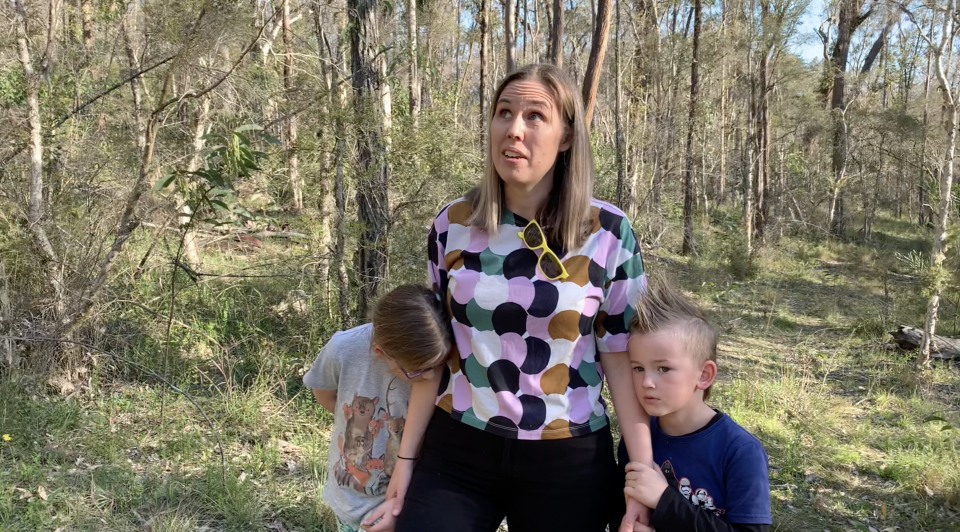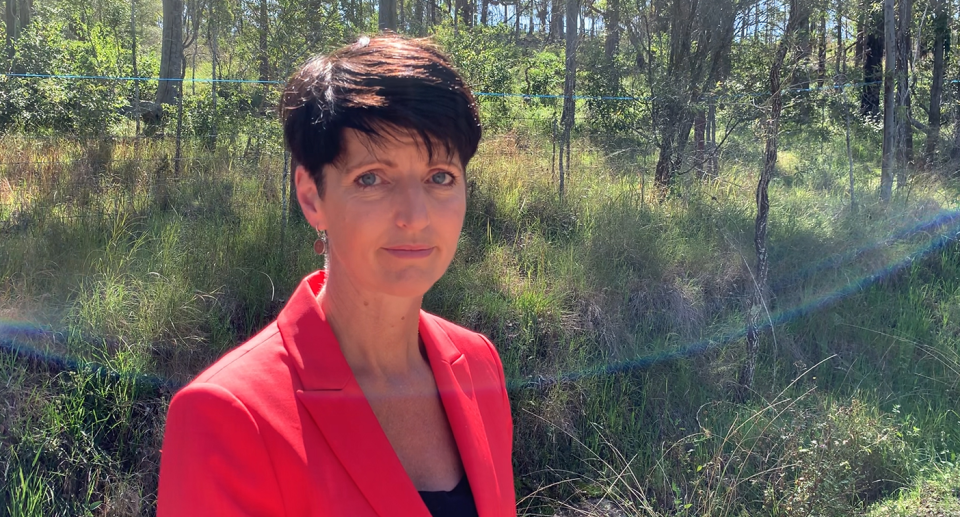'My heart bleeds': Mum fights to save koalas as mine expansion looms
A mother-of-three is working to stop a multinational mining company from bulldozing koala habitat at the end of her street.
Juggling home-schooling during coronavirus lockdowns and work commitments, Seaham, NSW, resident Chantal Parslow Redman already had her hands full before she began leading a grass-roots campaign to protect local wildlife.

Estimates suggest there are between 200 and 400 koalas living in greater Port Stephens, 33km north of Newcastle, and experts argue that the old growth forest surrounding the Brandy Hill mine is key to the health of the area’s small population hub.
Despite an outcry from vocal residents, the Independent Planning Commission (IPC) has given the developer, Hanson Australia, approval to bulldoze 54 hectares of bushland.
Walking alongside her children Neve, 7, Torin, 6, and Lars, 3, Ms Parslow Redman said green-lighting the mine’s expansion has left her “heartbroken to say the least”.

“Yes this is my backyard, but really it’s all of Australia’s backyard,” she told Yahoo News Australia.
“To know that these koalas and other animals here are facing potential destruction, well my heart bleeds for them.
“When will we start listening, and when will enough be enough?
“We need to do something, we need to do something now. It can’t be tomorrow.”
Kids learn about koalas in the bush
Walking through private property which borders the mining site, Ms Parslow Redman’s children search eagerly for koalas.
Torin casts his eye up a tree, while Neve scours the ground for koala poo.

Easily distracted by the sounds of the bush their mother calls her kids over and points out the silver glow emanating from the trees koalas like to feed on.
“Koalas love those trees,” she tells her kids.
“So if we look at those trees around here and we look right up to the top of the branches, we might see something.
Neve and Torin cast their eyes high in the sky. Their mum draws them in closer, reminding the pair about what they learnt about koalas during homeschool in “lockdown”.

“Why do koalas have white bottoms?” she asks.
“So they look like clouds when you look up.
Neve nods, saying “And when you look down they look like trees”.
“Exactly,” her mother says.
‘Not their lifetime’: Concern for future of koalas
Despite a NSW parliamentary inquiry warning in June that without “urgent government intervention” to protect native forests, the species faces extinction in NSW, the IPC approved the mine expansion on July 16 after what the state government described as a “comprehensive” assessment.
On Saturday afternoon, a locally trained tracking dog discovered droppings within a kilometre of the proposed development site which were identified as belonging to an adult and a juvenile by trained koala rescuer Kai Wild.


Following the discovery, NSW Labor environment spokesperson Kate Washington, who has been a critic of the approval of the mine expansion, described the situation as “really upsetting”.
“We’ve got children that are now seeing some koalas around the place, but we now risk seeing koalas becoming extinct in our lifetime,” she said.
“All the talk of wanting our grandkids to see koalas in the wild, yes we do, but the reality is they will not while we are continuing to bulldoze core koala habitat.”
Walking at a property close to the mine, Ms Washington said that following drought and a summer of bushfire, NSW cannot afford to lose any more koalas.
The area was one of the few areas fortunate to escape the flames of Black Summer, and could be key to ensuring the species’ survival according to local experts.

“We know that there are koalas here, the quarry is for gravel, it’s not like that can’t be found somewhere else,” Ms Washington said.
“It’s really frustrating when we know that koala populations are on the decline, that they’ll be extinct by 2050 unless urgent action is taken.
“How can something like this be approved?”
Koalas face ‘death by a thousand cuts’
With the NSW government having approved the bulldozing of the area, the final approval is now in the hands of federal environment minister Sussan Ley who is expected to deliver a decision on Tuesday.
The NSW department of planning noted that works cannot begin without Commonwealth approval and the required environmental management plans.
“In approving the project, the Commission imposed conditions requiring implementation of additional mitigation and offsets to address the impacts on native vegetation, including koala habitat,” a department spokesperson said in a statement.
“This includes implementing a detailed Biodiversity and Rehabilitation Management Plan to manage the clearing of native vegetation that will occur progressively over the 30-year life of the quarry, rehabilitating koala habitat on the site and conserving additional areas of habitat to offset the biodiversity impacts of the project.”

University of Newcastle researchers Associate Professor John Clulow and Dr Ryan Witt have written to the minister, calling on her to block the project and protect the koalas living in area.
Their 24-page report, commissioned by local koala advocates, concluded that destruction of the habitat would significantly impact the local population and disrupt breeding.
The researchers describe the mine expansion as a significant blow in the fight to save Port Stephens’ koalas as the species faces death by a thousand cuts through habitat fragmentation.
“If you take out 50 hectares down here, and someone else does a development out the front, eventually someone else will do another one,” Dr Witt said.
“That’s the chain reaction that we’re looking that will will leave koalas displaced and the populations in decline.”

The researchers argue that continued bulldozing of wildlife corridors will see the area’s koala populations isolated like on the Gold Coast, where animals are frequently impacted by cars and dogs as they attempt to navigate developments.
“Southeast Queensland is the perfect example of this playing out in the longer term,” Assoc Prof Clulow said.
“You take out small increments (of forest), and you say those small patches don’t matter, but when you add it up over time you find your (koala) populations drop by 50, 60, 90 per cent.
“That’s the process that plays out in this landscape as well as other places where koalas are.”
Developers to preserve 450 hectares in koala habitat offset
The mining company, Hanson Australia, told Yahoo News Australia in a statement they did not accept the findings by Dr Witt and Assoc Prof Clulow “as reported by some media”.
The multinational company, which is owned by German parent company Heidelberg Cement, said the proposed expansion area has been mapped as “marginal” in the Port Stephens koala plan.
They said the mine expansion will not sever any koala corridors, and that given the region’s koala populations were unharmed by last summer’s bushfires, “outcomes for the koala remain unchanged”.
'Something’s going to give': Platypus staring down the barrel of extinction
'Smoke and loud bangs': Endangered bats at risk as relocations go ahead
Devastated residents dread cull of beloved kangaroos living amongst them
Hanson said that they understand the importance of managing to site to ensure “risks to koala populations are limited”.
They said they will offset the development by preserving 450 hectares of koala habitat in perpetuity and abide by conditions set out by the NSW government.
Federal Environment Minister Sussan Ley and NSW Environment Minister Matthew Kean have been contacted by Yahoo News Australia for comment.
Do you have a story tip? Email: newsroomau@yahoonews.com.
You can also follow us on Facebook, Instagram and Twitter and download the Yahoo News app from the App Store or Google Play.




